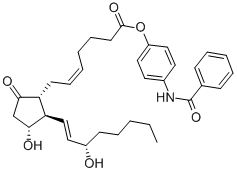PGE
2 p-benzamidophenyl ester is a crystalline derivative of PGE
2. PGE
2 is one of the primary COX products of arachidonic acid and one of the most widely investigated prostaglandins. Its activity influences inflammation, fertility and parturition, gastric mucosal integrity, and immune modulation.
1,2,3,4 The effects of PGE
2 are transduced by at least four distinct receptors designated EP
1, EP
2, EP
3, and EP
4.
5 Affinity constants (K
d) of PGE
2 for these receptors range from 1-
10 nM depending on the receptor subtype and tissue.
1. Willis, A.L., and Cornelsen, M. Repeated injection of prostaglandin E2 in rat paws induces chronic swelling and a marked decrease in pain threshold Prostaglandins 3(3),353-357(1973).
2. Jackson, G.M., Sharp, H.T., and Varner, M.W. Cervical ripening before induction of labor: A randomized trial of prostaglandin E2 gel versus low-dose oxytocin Am. J. Obstet. Gynecol. 171(4),1092-1096(1994).
3. Robert, A., Schultz, J.R., Nezamis, J.E., et al. Gastric antisecretory and antiulcer properties of PGE2, 15-methyl PGE2, and 16,16-dimethyl PGE2. Intravenous, oral and intrajejunal administration Gastroenterology 70(3),359-370(1976).
4. Arvind, P., Papavassiliou, E.D., Tsioulias, G.J., et al. Prostaglandin E2 down-regulates the expression of HLA-DR antigen in human colon adenocarcinoma cell lines Biochemistry 34(16),5604-5609(1995).
5. Coleman, R.A., Smith, W.L., and Narumiya, S. International Union of Pharmacology classification of prostanoid receptors: Properties, distribution, and structure of the receptors and their subtypes Pharmacol. Rev. 46(2),205-229(1994).
